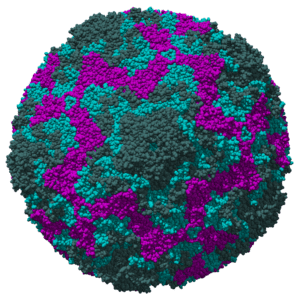

Enterovirus D68 (EV-D68) was first isolated from children with respiratory disease in 1962. No outbreaks of infection were detected until the late summer and early fall of 2014, and then in 2016 and 2018. During these epidemics of respiratory disease, some children developed polio-like paralysis. We have recently published a paper showing that isolates of EV-D68 from 1962 through 2014 are capable of infecting cells of the nervous system, disproving the hypothesis that neurotropism of the virus is a recently acquired phenotype.
Multiple isolates of EV-D68 from 1962, 2009, and 2014 were used to infect cortical neurons and astrocytes derived from human induced pluripotent stem cells. All viral isolates productively infected astrocytes, and all but one (from 2014) infected neurons. All the EV-D68 isolates replicated in brain slice cultures produced from young mice, a culture system that we previously used to study Zika virus neurotropism. Within the brain slices, the virus infected both neurons and astrocytes.
These observations clearly demonstrate that since 1962 EV-D68 has been able to infect cells of the nervous system. This property, called neurotropism, is not a phenotype that has recently been acquired by the virus, as has been put forward by others.
How then do we explain the sudden epidemic emergence of EV-D68 in 2014 and its association with paralysis?
Because our experiments involve application of virus directly to cells, we only measure the neurotropism of the virus. Whether or not the virus has recently acquired the ability to invade the central nervous system, a property known as neuroinvasion, is not known. However it is unlikely that EV-D68 would evolve to be neuroinvasive, as entry into the central nervous system is a dead end: the virus cannot leave and hence cannot be transmitted to others.
Addressing the origin of the EV-D68 epidemics beginning in 2014 might provide insight into infection associated paralysis. It is possible that the epidemic spread of the virus was a consequence of selection of a viral mutation that improved transmission among humans. Viral genome changes that increase viral reproduction, leading to higher virus titers in respiratory aerosols, could have this effect. The presence of higher virus loads in infected individuals could in turn have had an ancillary effect: to allow virus entry into the central nervous system. Unfortunately it will be difficult to identify such mutations. There is as yet no aerosol transmission model for EV-D68 infection, and as always, animal models do not always inform about what happens in humans.
A different aspect of the epidemiology of EV-D68 has been less discussed, and that is the role of non-viral factors in the epidemic spread of infection. In this case, lessons from poliomyelitis are instructive. Before 1900, poliomyelitis was a sporadic disease, and only isolated cases were reported. After that year, epidemics of increasing size were observed. The difference was ultimately traced to improvements in sanitation, including development of toilets and sewers. Before 1900, poor sanitation led to infection with poliovirus very early in life, when infants were still protected from paralytic disease by maternal antibodies. With improvements in sanitation, infection was delayed until a time when maternal antibodies were no longer present. Hence cohorts of increasing size became susceptible to infection and introduction of virus into these populations led to epidemics. In some ways it was fortunate that genome sequencing was not available in the early 1900s, which made us look elsewhere to solve the problem of the changing pattern of poliovirus infection. While genome sequencing can be enormously informative, it is all too easy to blame mutation for certain phenotypes; looking elsewhere might be more productive.
Is epidemic EV-D68 a disease of modern sanitation? Not in the same way as poliomyelitis was, but is it possible that improved sanitation has changed the microbiome of children to alter their susceptibility to infection with EV-D68? Perhaps climate change has led to conditions that favor aerosol transmission of the virus. Polymorphisms in the human genome could influence the susceptibility of rare children to EV-D68 associated paralysis, but why these would become penetrant only in 2014 is not clear. These and other hypothesis to explain epidemic emergence of EV-D68 should be explored before taking the easy route of blaming the viral genome.
